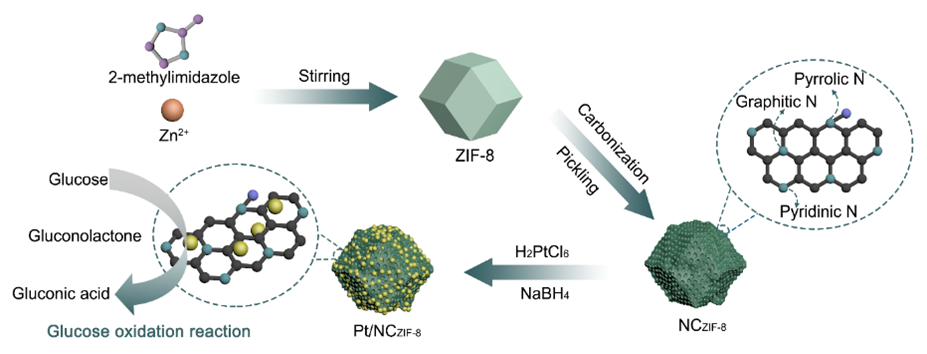From the perspectives of carrier and catalyst, our research group focused on solving the problem of insufficient electricity output caused by low oxidation rate of glucose in human body. The laboratory focuses on the morphology regulation of carbon carriers and platinum (Pt) -based catalysts to improve the loading rate and dispersion of Pt-based catalysts on carbon carriers, solve the problems of easy agglomeration and fewer active sites of traditional Pt-based catalysts in the reaction process, so as to effectively improve the glucose oxidation reaction rate and GFCs electricity output capacity.
1. Preparation and performance of ZIF-8 carriers
Using ZIF-8 as a precursor, NCZIF-8 carriers with a microporous structure were prepared. The Pt/NCZIF-8 composite was prepared by recombination of Pt NFs catalyst with NCZIF-8 support. This support enables the PT-based catalyst to be more uniformly dispersed, resulting in good stability of the catalyst system. The maximum power density produced by GFCs using 10% Pt/NCZIF-8 as anode catalyst was 0.48 μW·cm-2. A graded porous structure NMMC-2 carrier with micropore-mesopore coexistence was prepared by adding the surfactant PVP during the preparation of the ZIF-8 carrier. GFCs with 10% Pt/NMMC-2 as anode catalyst had higher power density (1.27 μW·cm-2), open circuit voltage (533.5 mV) and short circuit current density (0.02 mA·cm-2) compared with the microporous Pt/NCZIF-8.
2. Preparation and performance of Pt catalyst
Based on the chemical reduction method, Pt NFs catalysts with flower-like porous structure were prepared. This flower-like structure effectively increases the exposure of the active site in the catalyst, thereby increasing the catalytic efficiency in the reaction. The GFCs assembled with Pt NFs as anode catalyst had a maximum power density of 13.8 μW·cm-2, an open circuit voltage of 819.5 mV, and a short circuit current density of 0.12 mA·cm-2. To further improve the performance of electrocatalytic glucose oxidation, Pt NFs catalyst was compounded with NMMC support to prepare Pt NFs/NMMC composites. The GFCs assembled with 10% Pt NFs/NMMC composite as anode catalyst could generate a maximum power density of 3.24 μW·cm-2, an open circuit voltage of 765.1 mV, and a short circuit current density of 0.04 mA·cm-2, which could meet the needs of implantable medical devices.
The above work focuses on solving the problem of insufficient power output due to the low oxidation rate of glucose in the human body, and provides important guidance for the application of a new generation of low-power biological built-in chips. The relevant results have been published in ACS Applied Materials & Interfaces. ACS Applied Energy Materials, ACS Applied Nano Materials, Nanomaterials et al.

Figure 1. Schematic diagram of Pt/NCZIF-8 catalyst synthesis

